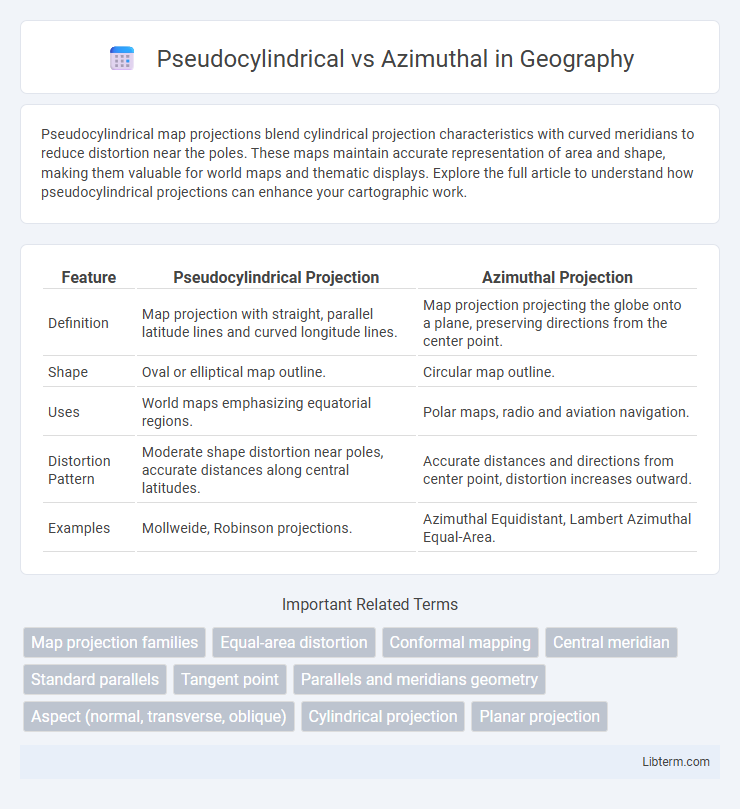Pseudocylindrical map projections blend cylindrical projection characteristics with curved meridians to reduce distortion near the poles. These maps maintain accurate representation of area and shape, making them valuable for world maps and thematic displays. Explore the full article to understand how pseudocylindrical projections can enhance your cartographic work.
Table of Comparison
| Feature | Pseudocylindrical Projection | Azimuthal Projection |
|---|---|---|
| Definition | Map projection with straight, parallel latitude lines and curved longitude lines. | Map projection projecting the globe onto a plane, preserving directions from the center point. |
| Shape | Oval or elliptical map outline. | Circular map outline. |
| Uses | World maps emphasizing equatorial regions. | Polar maps, radio and aviation navigation. |
| Distortion Pattern | Moderate shape distortion near poles, accurate distances along central latitudes. | Accurate distances and directions from center point, distortion increases outward. |
| Examples | Mollweide, Robinson projections. | Azimuthal Equidistant, Lambert Azimuthal Equal-Area. |
Introduction to Map Projections
Pseudocylindrical map projections preserve the shape of the central meridian and maintain consistent spacing of parallels, making them useful for world maps that balance distortion between area and shape. Azimuthal map projections project Earth's surface onto a plane, accurately representing distances and directions from a central point, often used for polar regions and air navigation. Both projection types serve different spatial purposes, with pseudocylindrical emphasizing equatorial regions and azimuthal focusing on local or hemispheric accuracy.
What Are Pseudocylindrical Projections?
Pseudocylindrical projections represent the Earth with curved meridians and straight, evenly spaced parallel lines of latitude, balancing area and shape distortion for thematic mapping. Unlike azimuthal projections, which preserve directions from a central point and often depict hemispheres or polar regions, pseudocylindrical maps are ideal for global visualization and maintaining relative sizes across latitudes. These projections, such as the Robinson or Mollweide, are widely used in world maps to present a more visually appealing and functionally accurate representation of the entire globe.
Key Features of Azimuthal Projections
Azimuthal projections maintain accurate direction from a central point, making them ideal for air navigation and radio signal mapping. These projections display great circles as straight lines, facilitating distance and bearing calculations from the center. Unlike pseudocylindrical projections, azimuthal maps effectively preserve angular relationships but may distort shapes and areas further from the center point.
Historical Development of Both Projections
Pseudocylindrical and azimuthal projections emerged during the 18th and 19th centuries as cartographers sought improved ways to represent the spherical Earth on flat maps. Pseudocylindrical projections, such as the sinusoidal and Mollweide, were developed to balance distortion across latitudes and maintain relative area representation, influencing thematic mapping and global data visualization. Azimuthal projections, including the stereographic and Lambert azimuthal equal-area, originated from mathematical analyses of Earth's geometry, enabling accurate directional properties useful in navigation and polar region mapping.
Geographic Distortions in Pseudocylindrical Maps
Pseudocylindrical maps minimize distortion along the central meridian but introduce increasing shape and area distortions toward the map edges, especially near poles. These maps balance scale between latitude and longitude lines, causing meridians to curve while parallels remain straight, which reduces distortion in mid-latitude regions. Azimuthal projections preserve accurate directions from the center point but distort shapes and areas increasingly toward the edges, contrasting the latitude-longitude balancing approach of pseudocylindrical maps.
Distortion Patterns in Azimuthal Projections
Azimuthal projections exhibit distortion patterns that increase as one moves away from the center point of projection, causing shape, area, and distance to become less accurate toward the edges. Unlike pseudocylindrical projections, which maintain consistent spacing along parallels and meridians, azimuthal projections preserve directions or distances only from the center, resulting in radial distortion. This makes azimuthal maps ideal for centered views, such as polar maps, but less suited for representing global features evenly.
Best Use Cases for Pseudocylindrical Projections
Pseudocylindrical projections are ideal for world maps emphasizing accurate representation of relative sizes and shapes along the equator with moderate distortion towards the poles, supporting thematic and educational purposes. They excel in displaying global data distributions such as climate patterns or population density where visual continuity along parallels is crucial. Azimuthal projections, while superior for preserving direction and distances from a central point, are less effective for global datasets compared to pseudocylindrical projections that balance area and shape distortion globally.
Ideal Applications for Azimuthal Projections
Azimuthal projections excel in applications requiring accurate direction and distance measurements from a central point, such as in air navigation and radio broadcasting. These projections are ideal for mapping polar regions due to their ability to represent great-circle routes as straight lines. Azimuthal projections also support global communication and meteorology by preserving angles and distances from the center, facilitating precise spatial analysis.
Key Differences Between Pseudocylindrical and Azimuthal
Pseudocylindrical projections represent the Earth with curved parallels and straight meridians, optimizing areas and shapes for mid-latitude regions, while Azimuthal projections project the globe onto a plane, preserving directions from a central point. Pseudocylindrical maps are commonly used for world maps due to their balance of distortion, whereas Azimuthal maps are ideal for polar and regional mapping where accurate direction from the center is crucial. The key difference lies in their distortion patterns: pseudocylindrical maintains shape and area more evenly, while azimuthal emphasizes correct azimuths and distances from a single point.
Choosing the Right Projection: Factors to Consider
Choosing between pseudocylindrical and azimuthal map projections depends on the specific application and geographic area of interest. Pseudocylindrical projections, like the Robinson or Mollweide, balance shape and area distortion across global maps, making them ideal for thematic world maps. Azimuthal projections, such as the Lambert azimuthal or Stereographic, preserve direction and distance from a central point, better suited for polar regions or localized navigation purposes.
Pseudocylindrical Infographic

 libterm.com
libterm.com